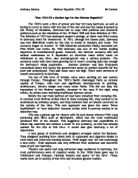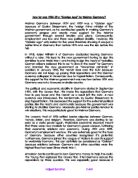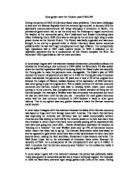Anthony Sohota Weimar Republic 1924-29 Mr Coulter
‘Was 1924-29 a Golden Age for the Weimar Republic?’
The 1920’s were a time of uproar and fear for many Germans. As well as having to come to terms with the loss of the war and also the losses imposed by the Treaty of Versailles, Germans had to cope with political and economic problems such as the rebellions of the 1919and 1920 and then inflation of 1923. The inflation of 1923 had destroyed people’s savings, so there was little money in Germany itself for investment. In 1924, through the Dawes plan, Germany was lent 800million marks by the USA to invest in industry and trade. The economy began to recover. In 1928 industrial production finally exceeded pre First World war levels. By 1930 Germany was one of the worlds leading exporters of manufactured goods. However, the German economy still had serious weaknesses as it depended on American loans which could be withdrawn at any time; also unemployment was a serious problem. The economy could well have been growing but it wasn’t creating jobs fast enough for Germany’s rising population. Another problem was that Employers complained about the money the government spent on welfare benefits for the poor and unemployed. They said taxes were too high. There were extremes of wealth and poverty in Germany. Yet out of this time of tension came some exciting art and culture through Europe. Throughout the 1920’s Berlin challenged Paris as cultural capital of Europe, with new and significant developments in painting, architecture, cinema design and many other fields. This did not help the reputation of the Weimar republic, however in the eyes if the right wing critics, its artists were declining traditional German values







